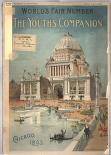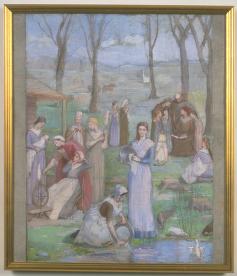|

"The Youth's Companion World Fair"

"Women of Plymouth"
|
Summary and Objective
Students will understand that the 1893 Chicago Columbian Exposition celebrated the past while introducing visions of the future. A battle of wills played out on the fairgrounds among the fair planners who believed that the overall design of the fair should represent innovation while others believed that Chicago would gain more respect as a cultural center by imitating more traditional styles. Students will investigate the question – Was the 1893 Exposition a window to the future or a look back at the past? – by engaging in an on-line scavenger hunt of websites of pictures and information about the Exposition in which they will examine aspects of American life presented at the fair. Topics will include American life and culture, art, technology, architecture, and America’s view of itself in the world.
Teaching Plan
Step 1.
Introduce the topic of the Exposition using a video clip or short handout about the fair. There are two excellent videos that are obtainable through the public library or other sources from which a 10-15 minute clip could be shown. These are: PBS – Chicago: City of the Century and Magic of the White City Expo – Chicago World’s Fair of 1893. In addition there is a 9-minute clip online at www.youtube.com/watch?v=eBpBl1Ngiyc&NR=1. You can also print and distribute to students a brief handout detailing the history of the fair from http://xroads.virginia.edu/~ma96/WCE/title.html or at Wikipedia.org (World Columbian Exposition).
Step 2.
Activator: Divide students into groups of 3-4 and distribute a copy of the map of the grounds of the Columbian Exposition to each group (or have students use the map on page 6 of "The Youth’s Companion World Fair” from the on-line documents, Document #2). Give students time to examine the map (it would be fun for students to be able to use magnifying glasses to examine the map if they are unable to view it online) and ask them to answer the following questions:
1. What types of exhibition buildings were included on the fairgrounds?
2. How was the fair organized?
3. Can you detect a pattern or structure to the arrangement of the physical space? Explain.
Share answers as a class; then ask students what they thought the purpose of the exhibition was based on their examination of the maps.
Step 3.
Divide the class into 5 groups. From page 14 of the online document “he Youth’s Companion World Fair (Document # 2),” divide students into groups based on the days 2-6 of the fair. Each group should read the description of what to do that day, navigate suggested websites to find photos of the interior and exteriors of the buildings mentioned, and then answer the following questions:
1. Describe the architecture of the building – do you think it is classical or modern in styling? Explain.
2. What would visitors have seen inside the building(s)?
3. Why do you think that this building and exhibition were part of the fair?
Have groups share their information with the class. Place answers on a white board or on large paper for future reference.
Step 4.
Wrap-up discussion of the initial question: In what ways was the 1893 Chicago Columbian Exposition both a window to the future as well as a look back at the past? It is suggested that this be done by having students place evidence from their investigation in a two-column chart, with a final debate to follow using the information. This could also be done as a foldable or written essay.
Step 5.
OPTIONAL VIDEO BEFORE DEBATE /DISCUSSION. View the 14 minute video on the role of the 1893 Exposition in shaping America’s world view of itself (http://youtube.com/watch?v=3wzyRepJuvM). The fair is viewed in the context of American expansion, with imperialism presented as a natural extension of westward expansion. In fact, Frederick Jackson Turner delivered his famous paper on the Significance of the Frontier in American History at what is today The Art Institute of Chicago during the 1893 Exposition. The fair presented the differences between “us” and “them,” when the exhibits are examined closely, especially on the Midway Plaisance.
Step 6.
POST ACTIVITY – American Art from the 1893 Exposition. Using the painting, “Women of Plymouth” (Document # 1 from on-line documents), by Lucia Fairchild plus others, including “Breaking Ties” by Thomas Hovenden and Mary Cassat’s “Modern Woman,” examine how this art reflected American values in the late 19th century. This could be expanded by examining the art in the Palace of Fine Arts as well. NOTE: other examples of art can be found at http://members.cox.net/academia/cassatt5.html.
Step 7.
ALTERNATIVE LESSON FOR LOWER ABILITY STUDENTS: The teacher could print copies of the photographs of some of the important buildings and spaces at the Exposition, and distribute each one to pairs of students. (Any of the web sites included with this lesson will provide ample pictures and information). Students could be asked to answer most, if not all, of the questions in step # 3 of the lesson. Charts or posters of the categories in Step # 3 could be placed around the room. Student pairs could be asked to place any relevant information from their photo analysis on the appropriate chart(s).
Suggested photographs might include: Administration Building; Agricultural Building; Manufacturing and Liberal Arts Building; Mines and Manufacturing*; Electricity Building*; Machinery Building*; The Woman’s Building*; Midway Plaisance; Transportation Building*; Palace of Fine Arts; Statue of the Republic; Court of Honor. Note: Items marked with an asterisk are available in Document # 1, “The Youth’s Companion World Fair (Document # 2 on-line documents).”
NOTE TO THE TEACHER:
This activity could be used in a broader sense to study the Gilded Age in American History. This activity brings together a study of art and culture, industry, architecture, politics, women’s issues, agriculture, and foreign policy. Other areas of investigation by students could be (a) The City Beautiful Movement; (b) the Beaux Arts Movement; (c) Daniel Burnham and Louis Sullivan, architecture; (d) Pullman City; (e) Genre Painting; (f) Frederick Law Olmstead; and (g) Notable Firsts at the Fair, including the Ferris Wheel.
In addition to the many websites, there are also a number of other excellent resources available for the teacher and the classroom. Excellent books include The Devil in the White City by Erik Larson; Celebrating the New World by Robert Muccigrosso; and America at the Fair: Chicago’s World Columbian Exposition by Chaim M. Rosenberg.
|




